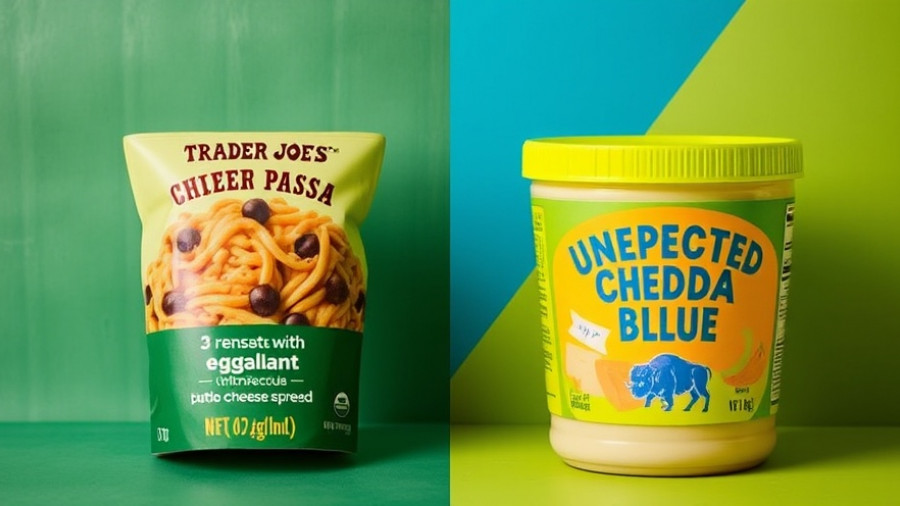
Discover the Cozy Flavors of Trader Joe’s Fall 2025 Lineup
As autumn settles in, food enthusiasts have much to discuss regarding Trader Joe’s fall lineup. This year, the beloved grocery chain has taken a bold direction by focusing on maple, offering a range of innovative flavors that are sure to excite both casual shoppers and fine dining aficionados alike. From maple butter tarts to new lamb options, it seems like Trader Joe's is really aiming to impress with a lineup that invites both nostalgia and a sense of adventure.
Uniquely Maple: Seasonal Standout Products
For those with a sweet tooth, items like the Maple Brown Butter Flavored Almonds excite taste buds with their buttery texture and crisp finish, evoking memories of cozy breakfasts in front of a warm fireplace. Meanwhile, the Salted Maple Cold Foam Creamer is a delightful addition to your morning coffee routine—adding a frothy layer that sings of salted caramel goodness. Yet, not every item in this lineup is a winner. The Maple Ice Cream Sandwiches, while adorable and fun, are structurally unsound, leading to a rather messy eating experience, though the maple flavor does quietly remind one of pancakes.
Fall Flops: Products That Missed the Mark
Just as exciting as the hits are the misses. The Cheese Plate Apizza Gouda Cheese and Buffalo Blue Unexpected Cheddar Cheese Spread fell flat, evoking more cringe than cheers among tasters. The gouda's rancid flavor and rubbery texture made it inedible, while the cheddar spread failed to deliver the heat that one would expect from its name. These products serve as a reminder that even Trader Joe's isn’t immune to the occasional culinary misstep.
Wild Innovations: Combining Culinary Trends
Another unique twist comes with the launch of the Peanut Butter and Jelly Sandwiches, a product that cleverly mirrors the classic Uncrustables but at a lower price point. The lawsuit surrounding this product’s similarities further indicates the competitive landscape of grocery retail, especially given that it fits into the broader scheme of enjoying childhood snacks revisited in a modern context. The introduction of new items like this shows Trader Joe’s commitment to not just meeting the expectations, but also innovating within the realm of seasonal snacking.
Try Before You Buy: Insider Tips for Fall Favorites
If you're planning a trip to Trader Joe's, consider adding a few must-try items to your cart based on real-time reviews:
- Cinnamon Coffee Cake Muffins: Light and fluffy with a gooey cinnamon swirl, these muffins are a top pick for a quick breakfast treat.
- Butternut Squash Mac & Cheese: With the perfect blend of spices, this comforting dish is a new autumn favorite that brings together the essence of fall in every bite.
- Japanese Mini Taiyaki: These candy-like snacks promise a delicious crisp exterior with a sweet filling that captivates the taste!
At a time when culinary experiences matter even more, particularly amid luxury food trends, these reviews emphasize why exploring seasonal offerings can elevate your dining and entertaining game.
Elevate Your Dining Experience with Trader Joe’s Finds
This fall, whether you're hosting a gathering or simply indulging in cozy nights at home, Trader Joe's is poised to bring back nostalgic favorites while also tantalizing taste buds with new creations. For fine dining enthusiasts and casual cooks alike, there's something special about discovering innovative flavors, like pairing maple-infused snacks with the best wine pairings for a cozy dinner party.
In conclusion, whether you love hosting lavish dinner parties with gourmet tasting menus or savoring snacks from the comfort of your couch, Trader Joe’s fall 2025 lineup offers a little bit of everything for every palate. Try the delightful maple products, but proceed with caution through the less-than-stellar items. Happy autumn shopping!
 Add Row
Add Row  Add
Add 




Write A Comment